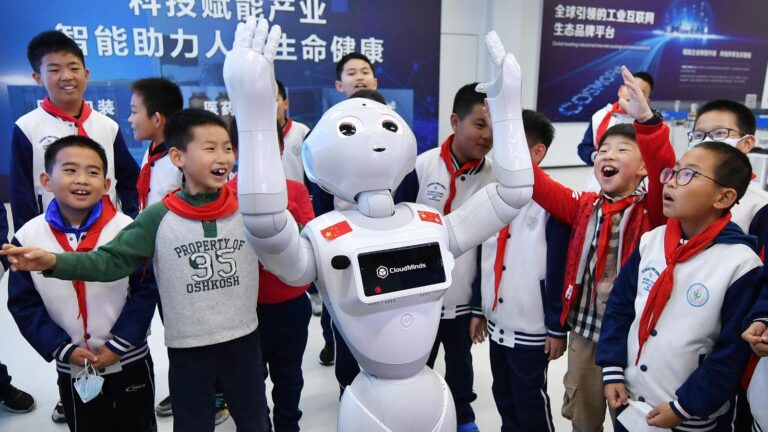Top line
China is well ahead of its international rivals in the global race for generative AI patents, a new United Nations report showed Thursday, leaving the United States and other nations far behind as they vie for strategic advantage and leadership in the transformative technology.
China’s patents don’t mean they’re winning the AI race, one expert tells Forbes.
Highlights
China has filed more than 38,000 patents for generative AI inventions since 2014, according to the World Intellectual Property Organization (WIPO), the United Nations agency responsible for overseeing international patent recognition and other matters.
Generative AI is AI software that can generate outputs such as text, images, video, and audio in response to a prompt, and generative AI inventions include chatbots like OpenAI’s ChatGPT and Anthropic’s Claude, image generators like Adobe’s Firefly, and even scientific tools like the Massachusetts Institute of Technology’s protein structure AI, FrameDiff, and Google DeepMind’s AlphaFold.
The figure, which does not take into account other forms of AI such as autonomous driving, reveals that China has filed more patents for inventions involving generative AI than all other countries combined, accounting for 70% of the more than 50,000 patents filed worldwide over the past decade.
The United States, with nearly 6,300 patents filed since 2014, is a distant second, less than a sixth of China’s total, followed by South Korea (4,155), Japan (3,409) and India (1,350) in third, fourth and fifth positions, followed by the United Kingdom (714), Germany (708), Canada (549) and Israel (311).
While the number of patents certainly speaks to China’s strength in research and development, Van Anh Le, an assistant professor of intellectual property law at Durham University in the United Kingdom, told Forbes that it “doesn’t tell the whole story.”
“The quantity of patents does not necessarily reflect their quality or the impact of the innovations,” Le said, explaining that many of them could be of “low significance” or represent “incremental improvements rather than breakthroughs.”
Crucial Quote
“In AI, the competition between China and the U.S. is undeniable,” Le said, describing China as “a formidable competitor.” But patent data only provides a partial picture, Le said. “To get a more complete understanding, we also need to look at other indicators, such as startup activity, which can indicate the health of the innovation ecosystem,” as well as the pace at which patents are being commercialized. Taking this broader view of AI, Le said the U.S. has a “robust innovation environment,” noting the many AI startups emerging from it.
Which companies own the most AI patents?
Globally, Chinese giants Tencent, Ping An Insurance Group and Baidu are by far the holders of the most generative AI patents, according to WIPO, each holding several times the number of patents of the other holders in the global top 10. Chinese entities account for six of the top 10 global generative AI patent holders over the reporting period, WIPO said, with the Chinese Academy of Sciences the only research organization to make the top 10. IBM, which ranks fifth globally, holds the most patents of any U.S. company.
Top 10 Generative AI Patent Holders in the World
- Tencent Holdings (2,074)
- Ping An Insurance Group (1,564)
- Baidu (1,234)
- Chinese Academy of Sciences (607)
- IBM (601)
- Alibaba (571)
- Samsung Electronics (468)
- Alphabet/Google (443)
- Octet Dance (418)
- Microsoft (377)
What should you pay attention to?
Generative AI accounts for just 6% of global AI patents, but the number of new filings has accelerated rapidly in recent years, WIPO said. More than a quarter of generative AI patents were filed in 2023 alone, for example, a year that also accounted for nearly half of all scientific publications on generative AI. WIPO said that video and image data dominate generative AI patents, with around 18,000 inventions, followed by inventions for text (13,494) and speech and music (13,480). Generative AI can be deployed across a wide range of sectors, and WIPO said that in the future it could help design new medicines, power customer service chatbots, and improve product design and autonomous driving. Life sciences in particular appear poised for change, WIPO predicts, with the number of GenAI patents using data based on molecules, genes and proteins “increasing rapidly” in recent years at an average annual growth rate of 78% over the past five years.
Key context
Generative AI has been around for years, but interest and adoption of the technology have grown rapidly. The release of OpenAI’s ChatGPT assistant in 2022 marked a particular inflection point, sparking a global race among companies developing and deploying AI tools. McKinsey estimates that the growing economy of generative AI could add up to $4.4 trillion per year to the global economy, meaning that controlling key inventions through patents could be very lucrative. The technology also has strategic advantages, and global powers like the United States and China have made its control and excellence national priorities.
Contra
China isn’t alone in having a head start on AI patents, Le said, explaining that China has outpaced the U.S. in patent filings across the board for years. While high patent numbers are indicative of research capacity, high investment and technological prowess, there are other ways to explain the trend, Le said. “Different countries have different policies and practices regarding patents” that can skew or inflate the numbers without reflecting real-world innovation, Le said. In China, these factors include government subsidies, tax breaks and social benefits for patent applicants, which can encourage filings to collect benefits rather than to protect real discoveries. Patent applications can also be motivated by other motives, such as seeking government employment, promotion or reputation, Le said.
Get Forbes Breaking News SMS Alerts: We send you SMS alerts so you’re always up to date on the biggest stories making headlines today. Text “Alerts” to (201) 335-0739 or sign up here.
Further reading


